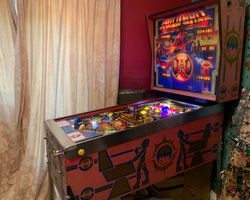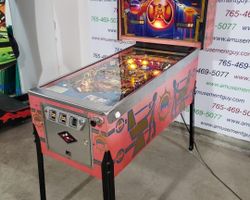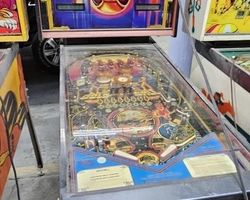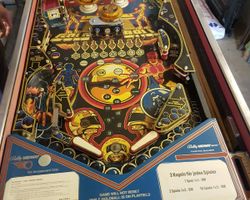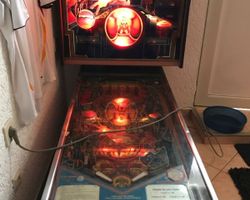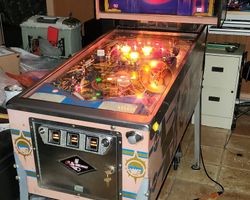Gold Ball

Average Prices: USD $300 to $1,600
Produced: October, 1983
Production Run: 1,750 units
Machine Type: Solid State Electronic
MPU: Bally MPU AS-2518-133
Players: 4
Design by: George Christian
Art by: Tony Ramunni
Gold Ball, a solid-state electronic pinball machine released by Bally Manufacturing Co. in October 1983, occupies a distinctive place in pinball history. As the successor to Bally's earlier Silverball, it revisited the unique concept of a special, high-value ball, a mechanic previously explored by Chicago Coin's 1947 machine also named 'Gold Ball'. Bally's 1983 iteration was designed by George Christian, with striking artwork from Tony Ramunni, and software by Rehman Merchant. It signaled a shift in Bally's design philosophy, moving towards more direct and perhaps simpler playfield layouts compared to some of their more complex predecessors, while retaining compelling gameplay elements. With a production run of 1,750 units, Gold Ball was introduced to the market with the bold marketing slogan, "The Future of Pinball Has Just Arrived," aiming to capture attention with its central, score-multiplying gimmick.
Signature Features and Design
The defining characteristic of Gold Ball is its namesake feature: a special gold-colored ball that, when in play, triples all scores, including the end-of-ball bonus countdown. Unlike many games of its era that introduced multiball play, Gold Ball utilizes two distinct balls—one standard silver, one gold—but never simultaneously. The activation of the gold ball mechanic saw an important evolution. Initially, the machine came from the factory with an operator-adjustable percentage setting (1-15%) for the random release of the gold ball into the shooter lane, often awarded as an extra ball. This random chance, while providing a surprising thrill, limited the strategic depth for competitive play.
Recognizing this, Bally released a field service kit, which included a software update (U-2 ROM), transforming the gold ball feature into a skill-based objective. With this upgrade, players could earn the gold ball by spelling "G-O-L-D-B-A-L-L" through specific playfield shots. Once spelled, the gold ball would be issued as an extra ball after the current ball in play was lost. This shift from random chance to player agency dramatically enhanced the gameplay experience, making the pursuit of the gold ball a core strategic element rather than a fortuitous bonus.
Beyond its unique ball mechanic, Gold Ball features artwork that contributes significantly to its identity. Tony Ramunni’s playfield and backglass artwork are notable for their vibrant colors and fantasy-themed visuals, presenting a captivating tableau for players. The playfield art is visually clean and uncluttered, contributing to the open layout. While the cabinet artwork is simpler, utilizing lighter colors, the overall aesthetic on the playfield and backglass effectively complements the game's central fantasy concept. The machine also incorporates a digital display, which was standard for its generation.
Playfield and Mechanics
The playfield of Gold Ball is characterized by its open, uncluttered layout, which contributes to its fast gameplay. This design philosophy emphasizes shot accuracy and ball control, providing clear lines of sight to all targets. The primary objective, spelling "G-O-L-D-B-A-L-L," is integrated directly into the playfield design through several key shot opportunities.
Central to the "Gold Ball" spelling mechanic is the center standup target. Hitting this target advances one letter in the "G-O-L-D-B-A-L-L" sequence, though its effectiveness is influenced by a rotating arrow indicator, adding a layer of timing and precision. Two star rollovers, one upper and one lower, also contribute to spelling the word, providing alternative pathways to progress. The left crossover return lane serves a dual purpose, acting as an outlane saver that can also spot a letter, making a risky save potentially more rewarding.
Other significant playfield elements include three pop bumpers, which provide dynamic, unpredictable ball action in the upper playfield. A single spinning target offers a high-scoring opportunity, particularly when hit repeatedly. This spinner shot is often a prime target, especially when illuminated, as it can lead to bonus advancements and other awards via the top lanes. In the upper right corner, a bank of 1-2-3 touch targets is strategically placed, allowing players to multiply their end-of-ball bonus, adding another layer of scoring strategy. The playfield also features seven standup targets in total, offering various points and objectives. Despite its seemingly simple layout, the game design includes areas prone to "death shots," particularly near and between the flippers, demanding constant player vigilance and precise flipper work to prevent frustrating drains. The lighting on the playfield, while not as complex as later machines, effectively highlights active targets and scoring opportunities, guiding the player's attention towards the immediate objectives.
Gameplay Dynamics
The core gameplay loop of Gold Ball revolves around the pursuit and maximization of the gold ball's triple-score multiplier. Without the skill-based ROM, gameplay could feel more random, but with the U-2 ROM installed, the game transforms into a strategic challenge. Players must consistently hit the center standup target, star rollovers, and the left return lane to spell "G-O-L-D-B-A-L-L." Each successful hit lights a letter, building anticipation for the moment the full word is spelled. Once achieved, the gold ball is held in reserve, ready to be launched into play as an extra ball after the current silver ball is lost.
When the gold ball is in play, the game's dynamics shift dramatically. Every point scored, from basic target hits to bonus countdowns, is instantly tripled. This creates an intense scoring window, where maximizing every shot becomes paramount. Strategies often involve chaining spinner shots, hitting bonus multiplier targets (like the 1-2-3 bank), and aiming for high-value rollovers. The challenge is amplified by the machine’s fast pace, requiring quick reflexes and accurate flipper control to keep the precious gold ball in play for as long as possible. A noteworthy aspect is the possibility of earning another "Gold Ball" while one is already in play, which effectively queues up another high-scoring opportunity.
While Gold Ball lacks features common in later machines, such as speech, multi-ball modes, or extensive drop target banks, its unique focus on the single, high-value gold ball mechanic provides a distinct experience. The absence of these elements means the game is less about intricate rule sets and more about pure shot-making and managing the risk-reward of hitting crucial targets, particularly the center target that can sometimes lead to direct drains. The audio design, while lacking speech and continuous musical compositions, delivers impactful sound effects often praised for their quality and ability to enhance the gameplay, reminiscent of other acclaimed Bally titles and classic arcade games. The constant background sound loop, while sometimes noted, is characteristic of many pinball machines from this era.
Reception and Legacy
Gold Ball has garnered a mixed yet generally positive reception within the pinball community, largely dependent on whether the machine has been updated with its skill-based ROM. Without this crucial software upgrade, the random nature of the gold ball release often led to complaints about a lack of player agency and strategic depth, occasionally being described as repetitive. However, with the U-2 ROM, the game's standing significantly improves, transforming it into a fast, challenging, and rewarding experience centered on the strategic pursuit of the gold ball.
Strengths frequently cited include the game's impressive speed and challenging shot opportunities, particularly the high-risk, high-reward center target. The sound effects are consistently praised, often highlighted as exceptional and contributing significantly to the gameplay's energetic feel. Players also appreciate the clear, vibrant playfield and backglass artwork, which effectively communicate the machine's theme. For collectors, its status as a transitional Bally game – bridging the gap between their earlier complex designs and later, often simpler systems – makes it an interesting historical piece. Many consider it a solid choice for a first pinball machine due to its relative affordability and straightforward, yet engaging, gameplay.
Conversely, some criticisms persist. The machine's inherent simplicity, especially compared to Bally’s more feature-rich games from earlier years, is sometimes noted. The lack of speech and continuous background music, while typical of some machines from 1983, is seen as a drawback by players accustomed to more advanced audio packages. The basic cabinet artwork is also occasionally mentioned. Despite these points, Gold Ball maintains a distinct identity due to its central "gold ball" gimmick. Its legacy is tied to its unique mechanic and its role in Bally's evolution. It demonstrated how a singular, well-executed feature could define a game, and how post-release software updates could fundamentally alter a machine's playability and community standing. Gold Ball remains a notable example of a pinball machine that, while not universally acclaimed, holds a special place for enthusiasts who appreciate its direct gameplay and the thrill of tripling their scores with the elusive gold ball.
Sponsored Links
 Ebay Listings
Ebay Listings
 Auction Results
Auction Results
| Cost | Location | Date |
|---|---|---|
| GBP £1,532 |  Brockenhurst, United Kingdom Brockenhurst, United Kingdom |
29 August, 2025 |
| USD $2,275 |  Indiana, United States Indiana, United States |
02 March, 2025 |
| USD $675 |  Ohio, United States Ohio, United States |
16 November, 2024 |
| EUR €1,210 |  Nordrhein-Westfalen, Germany Nordrhein-Westfalen, Germany |
24 September, 2023 |
| USD $1,395 |  Texas, United States Texas, United States |
03 August, 2023 |
| EUR €755 |  Baden-Württemberg, Germany Baden-Württemberg, Germany |
07 May, 2023 |
| USD $2,000 |  Ohio, United States Ohio, United States |
07 May, 2023 |
| GBP £1,600 |  Prescot, United Kingdom Prescot, United Kingdom |
05 November, 2022 |
| EUR €2,000 |  Rheinland-Pfalz, Germany Rheinland-Pfalz, Germany |
26 June, 2022 |
| USD $2,650 |  Ohio, United States Ohio, United States |
04 May, 2022 |


Private Policy · Search Website · Contact Us
As an eBay Partner, we may earn a commission from qualifying purchases made through links on this site, at no additional cost to you.
All trademarks and copyrighted materials remain property of their respective owners. All other content copyright 2007 - 2025 Pinpedia.

